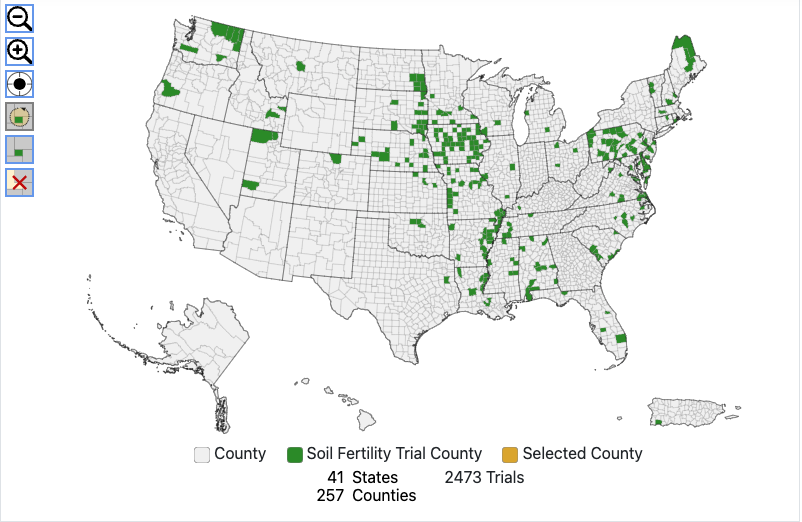
With significantly higher than normal precipitation, northeastern South Dakota has experienced a very difficult spring. In many cases, producers need to make difficult planting decisions as spring slips away.
Annual forages or early summer cover crops can be a helpful alternative in these late planting situations and often work well within the crop insurance system. There is no ‘hard and fast’ blanketed mix or species that can be recommended to all producers, as each grower is in a unique circumstance with a different production environment and goals, soil types and management techniques. Rather than seeking the ‘go-to’ crop or mix of your neighbor’s choosing, ask yourself a few fundamental questions before planting an alternative option.
Factors to Consider
Herbicide History
Before planting an alternative to your intended crop, consider your crop rotation, as well as haying/chopping and grazing restrictions of herbicides previously applied; this includes herbicides applied in the previous growing season. For more considerations regarding herbicide carry-over, view this resource.
Purpose
Always begin with the end in mind. Livestock feed, soil health, weed suppression, nutrient capture, soil moisture management, additional harvested forage, and grazing may all be common reasons to plant a cover crop. Try focusing on your own objectives when creating a planting plan. The SD Cover Crop Poster lists common South Dakota cover crops and their purpose ratings, seeding rates and seeding depths.
Insurance and Farm Service Agency (FSA) Guidelines
Be sure to check with your insurance agent and FSA representative on all details regarding the seeding of your cover crop or forage crop. The prevent plant date for “haying, grazing, or chopping cover crops” has been changed to “any time” as of 2021 to “support the use of cover crops” according to the USDA Risk Management Agency. Frequently asked questions and answers regarding insurance can be found on the Risk Management Agency (RMA) website.
Seed Availability and Price
Each year, demand for annual forage/cover crop seed varies, and some species may have risen in price due to demand. This is important to take into consideration before choosing a species or mix to plant. Although most producers want to keep costs low, do remember that forage crops and/or improved soil health comes at a price, and some investment will be necessary.
Crop Rotation
Keep your previous crop and intended crop for 2023 in mind; it is generally recommended to plant cover crops of diverse growth habits that are complementary to the subsequent cash crops, i.e. primarily broadleaves prior to grass cash crops and vice versa.
Termination
Many cover crops will winter kill or die after a late chopping. However, some species may survive the winter, such as cereal rye, winter wheat, triticale, etc. Some species, such as vetch and Italian ryegrass can stay dormant for a prolonged period (hard seed) and germinate the following spring. This does not eliminate these crops as an option; it simply requires prompt spring attention and management, as these species may be of great value to utilize excess moisture in a potentially wet spring.
Weed Control
When planting a diverse cover crop mix, it can be nearly impossible to chemically control weeds during the growth of the cover crop. If a mix is well planned and raised under ideal growing conditions, the cover crops can usually out-compete weeds. However, if particular weeds are a concern, control issues should be considered before selecting cover crops. A thorough burndown before planting also helps with weed suppression. Cereal/winter rye is known for its inherent allelopathic characteristics, i.e. its ability to suppress weeds by the production of biological chemical substrates that are harmful to other surrounding species. Other cool-season grasses and sprawling, or more ground covering, broadleaf crops (such as vetches, or radish and turnip) can also aid in weed suppression.
Soil Fertility
If a producer is intending to use cover crops as forage, applying lower rates of nitrogen at planting can be cost-effective in the end. Consider previous crop credits if legumes were planted and current soil test levels. In many situations, low nitrogen application rates (30-60 lbs./a) will provide considerable growth for cover crops (especially grasses); it is also important to apply the appropriate rate of nitrogen when planting for forage purposes to limit the level of possible plant tissue nitrate-N accumulation should plants experience drought or other stresses. Check the South Dakota Fertilizer Recommendations Guide for suggested soil fertility guidelines for major South Dakota crops.
Planting Time
As most cover crops are grown in blends, it is difficult to establish an exact seeding date based on individual crop species. However, there are suggested planting windows for crop types based on the proportion of different cover crops species in the blend. Warm-season species (such as forage sorghums, sorghum-sudangrass, buckwheat, sunflower, teff grass, etc.) should ideally be planted from late spring into early summer. After the third week of July, as average daily temperatures tend to decrease due to lower nighttime temperatures, cool-season species (such as small grains, peas, clovers, vetch, and brassicas) are recommended instead. When planted within these suggested guidelines, cover crops should have ample growth time for forage harvest near or after Sept. 1. Due to growth habit, some species in the mix may mature faster, which should not inhibit forage harvest.
Silage/Forage Considerations
If corn silage is not an option, consider a couple close alternatives, such as forage sorghum, or sorghum-sudangrass. In some studies, forage sorghum was ~85% the feed value of corn silage. Additional grain could be included in the diet to meet performance objectives compared to feeding corn silage. Sorghum-sudangrass with the Brown Mid Rib (BMR) trait may be slightly lower in energy content, but produces fiber digestibility similar to corn silage. Although forage sorghum can be an excellent feed alternative to corn, it generally has a short cutting window at mid-to-hard dough, and can be difficult to harvest at the proper moisture (62-72%), especially if the crop is direct cut (not wilted prior to chopping). In some cases, non-heading types will require a killing frost in order to get plants dry enough for ensiling, which causes quality losses. If forage sorghum is too wet at harvest, corn grain or other forage dry matter can be added to the pile or bunker.
Sorghum-sudangrass can be a bit lower in energy content than forage sorghum, but does not necessarily have to be direct cut and can be wilted in the field before chopping if needed. In this case, as long as ideal moisture content is reached (~62-72%), no extra dry matter would be needed in the ensiling process. Sudangrass species are often suited as a rescue forage, because their thinner stems allow for faster dry-down for silage, green chop and, in some cases, hay. Sudangrass and sorghum-sudangrass hybrids have the added advantage of post-harvest regrowth, providing the potential for an additional harvest or extended grazing.
Keep in mind that prussic acid poisoning can be a problem with either of these grasses. It’s found in highest concentrations in the leaves and new shoots, typically following a freeze, making cattle susceptible to poisoning. Frost and drought increase prussic acid content, and grazing should be delayed for about 10 days to allow the toxin to dissipate. Prussic acid is less of a concern in harvested feeds. For more information regarding feeding sorghum or sudangrass forages, view ISU's Sudan/Sorghum Forage Management Publication.
"Although there are many factors to take into consideration, annual forages and cover crops can be an excellent tool to mitigate the challenging planting season. "
In Summary
Although there are many factors to take into consideration, annual forages and cover crops can be an excellent tool to mitigate the challenging planting season. Cover crops not only reduce fallow acres, but also enhance soil health and provide supplemental forage. For more information, please do not hesitate to contact your nearest SDSU Extension Regional Center or local NRCS office for cover crop/forage crop recommendations and other assistance.
Resources
Resources for Cover Crops in South Dakota, NRCS South Dakota


